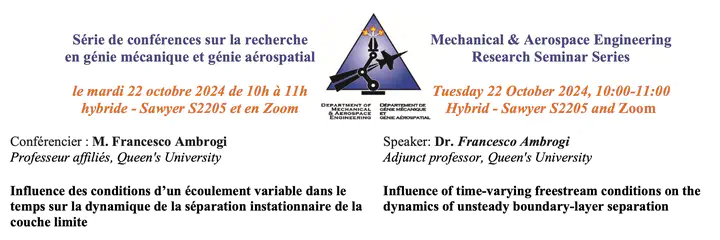Influence of time-varying freestream conditions on the dynamics of unsteady boundary-layer separation
 Image credit: Ambrogi Seminar
Image credit: Ambrogi Seminar
Abstract
This work studied the effects of time-dependent freestream pressure-gradients on the unsteady separation process of a flat-plate turbulent boundary-layer (TBL), with the goal to increase our fundamental understanding of the physics of separated flows. First, we carried out wall-resolved large-eddy simulations of TBLs subject to unsteady freestream forcing at several reduced frequencies (k). We observed that the dimensions and behavior of the resulting turbulent separation bubble (TSB) greatly changed depending on k, and that flow inertia and history effects played a significant role in the development of the flow. We also discovered that when the convective timescale of the flow matched the unsteady imposed timescale, the separation region was advected downstream as a rigid body. Next, we delved into the dynamics of the advection of the TSB. The time evolution of turbulent kinetic energy (TKE) revealed that an advection-like phenomenon was also present at very low frequency though its physical mechanism was completely dominated by shear. At k = 1, on the other hand, the advected structure was rotational in nature and moved at constant speed. Furthermore, particle paths showed that, as the bubble moved downstream, it was able to maintain its shape by extracting energy from the surrounding fluid. Lastly, we investigated the effects of the time-dependent freestream forcing on unsteady separation by fixing the frequency of the oscillation and analyzing several freestream pressure distributions. In contrast to a previous numerical study, we found that every case, at k = 1, is characterized by the advection downstream of turbulent structures. However, when the change in time of the freestream pressure gradient was not enough to significantly shrink the TSB, the advection mechanism was shear dominated, the bubble remained in the domain and underwent a breathing motion, which was synchronized with the freestream forcing.